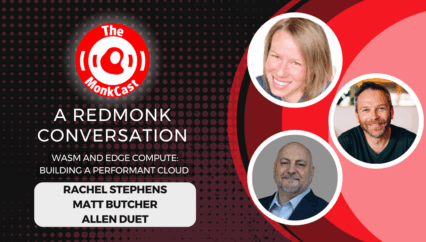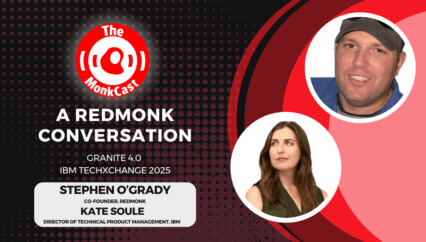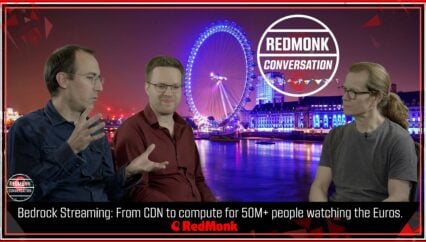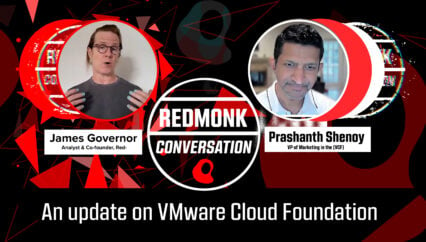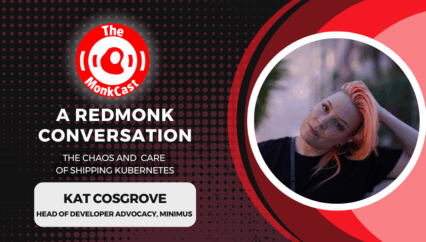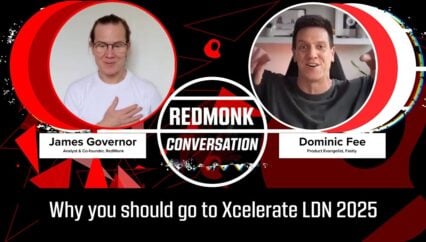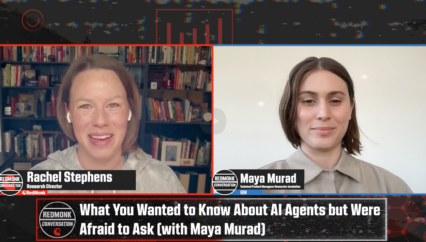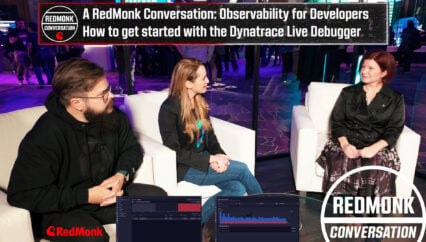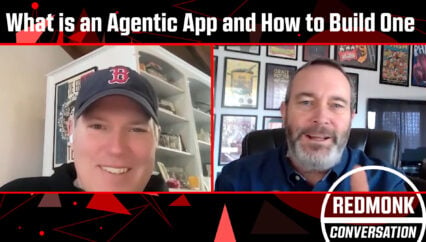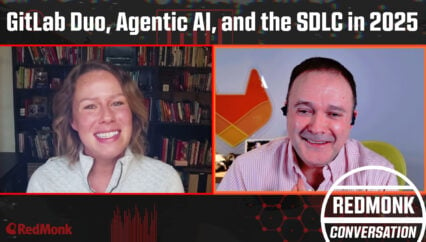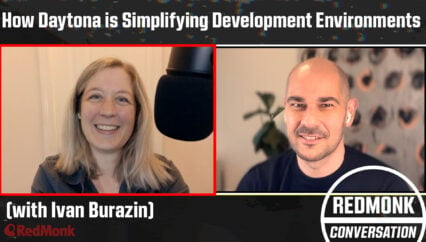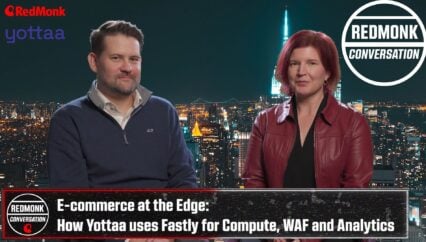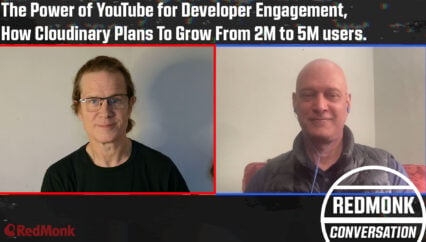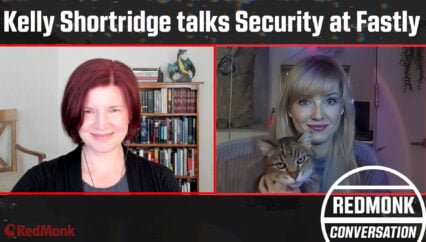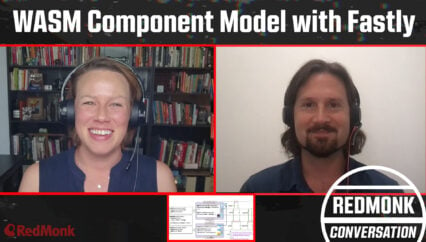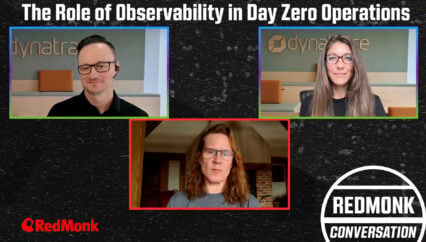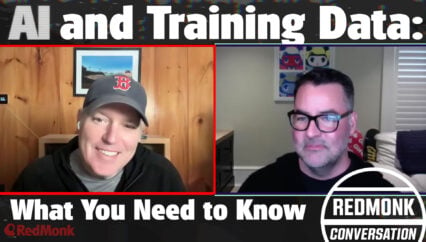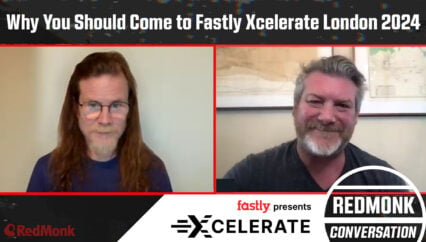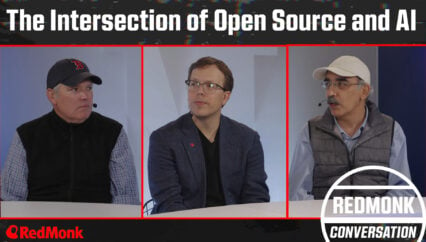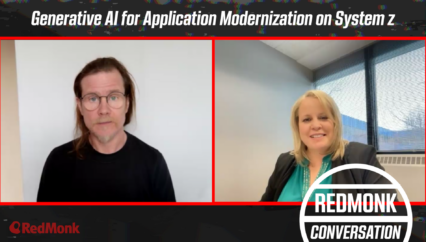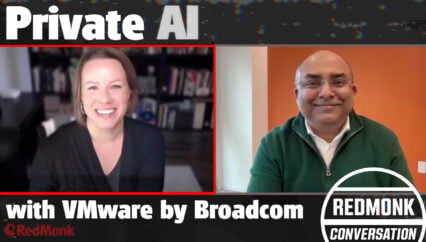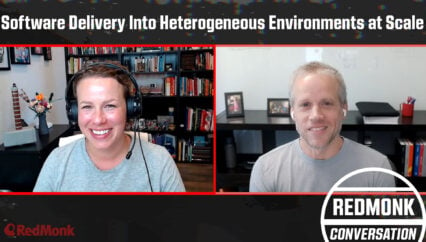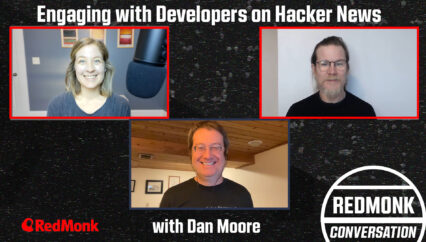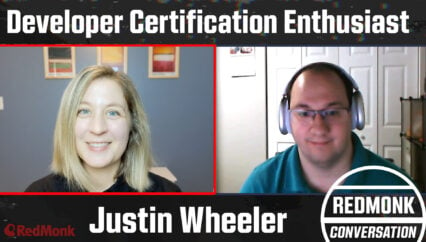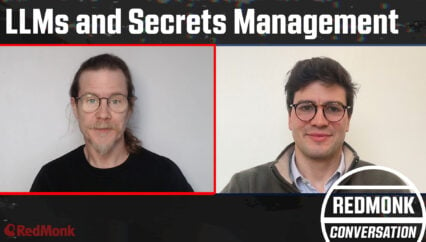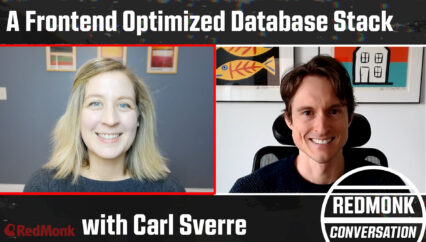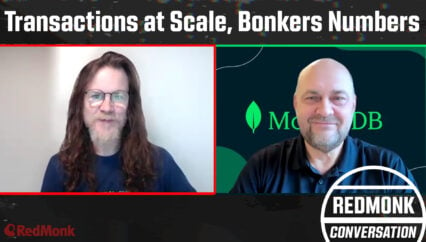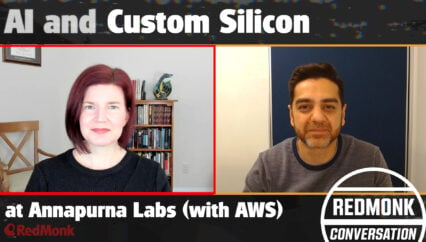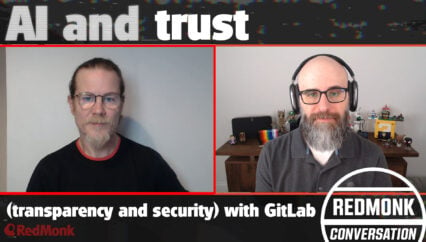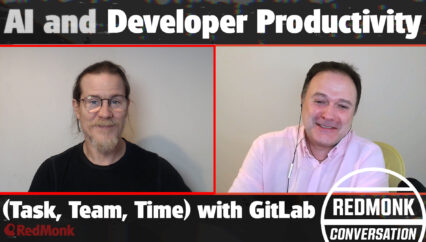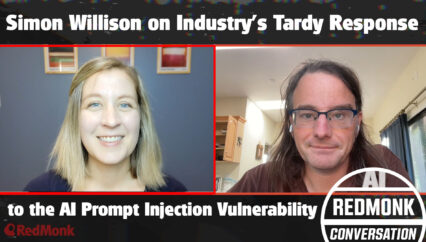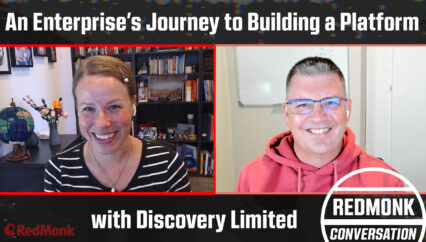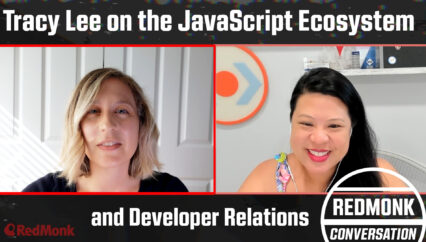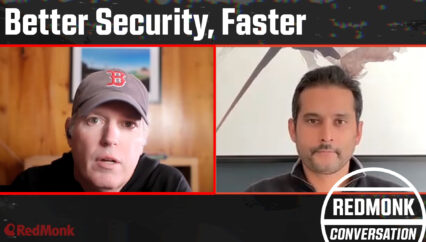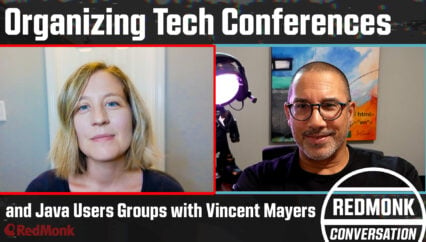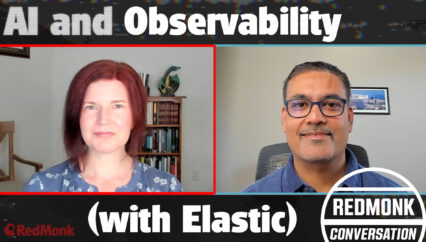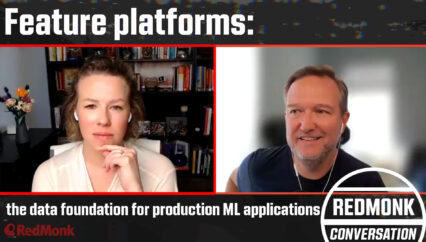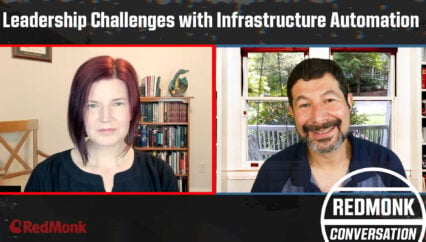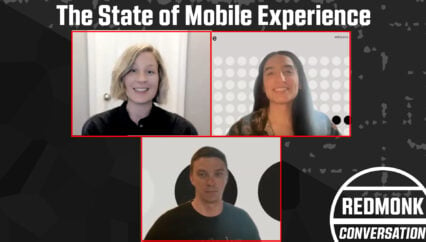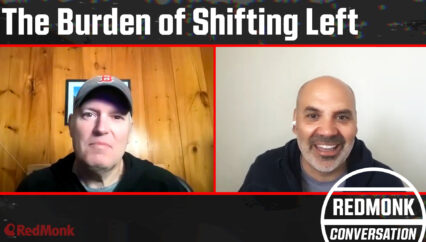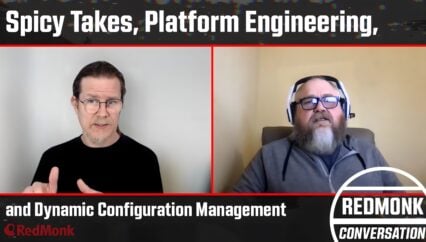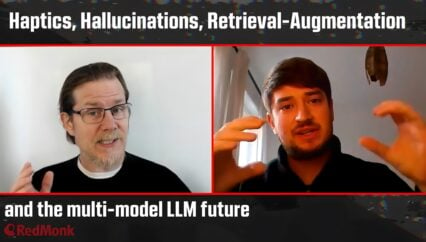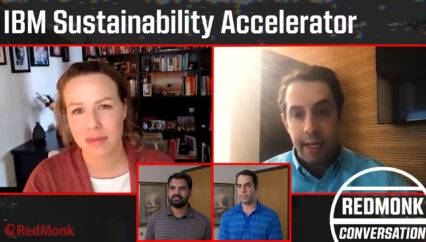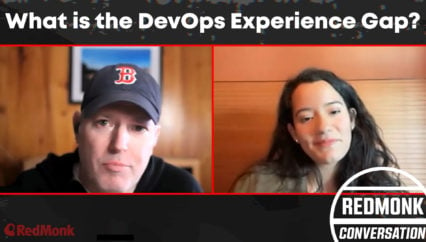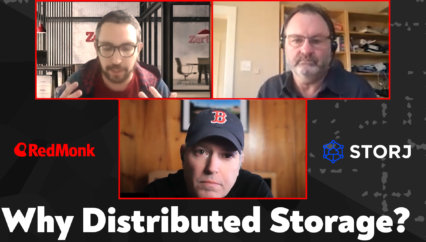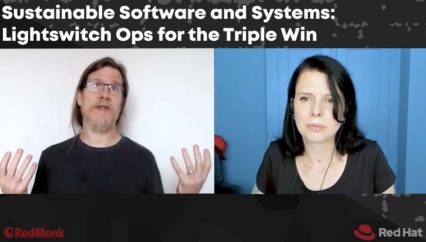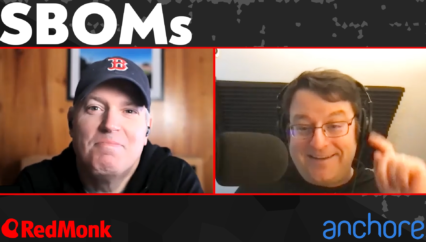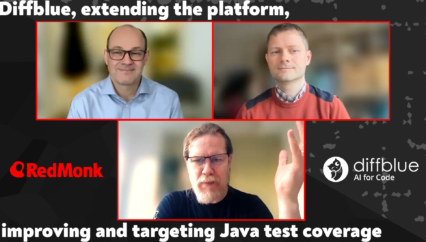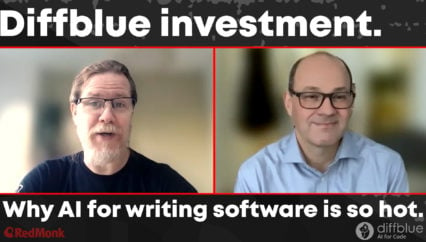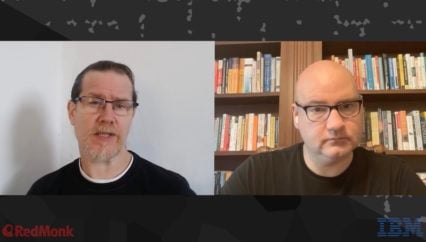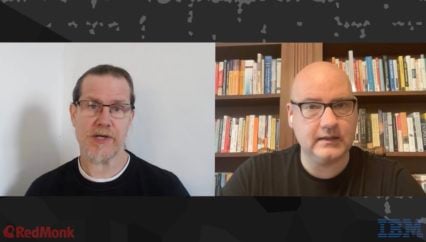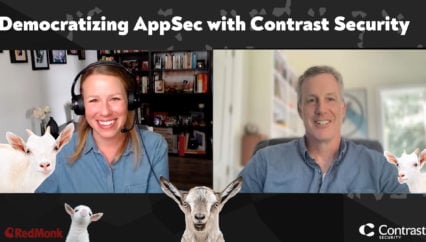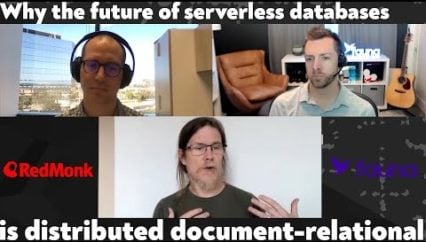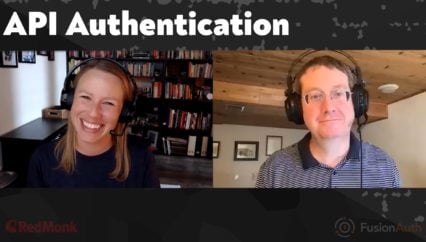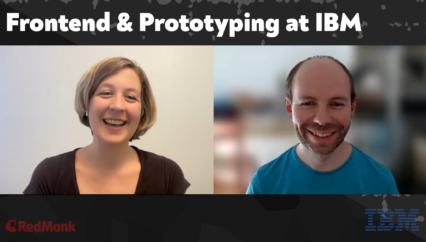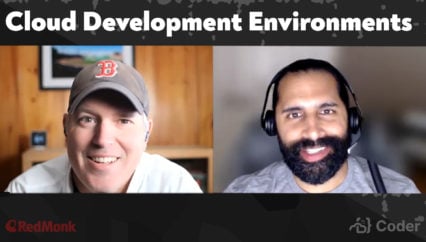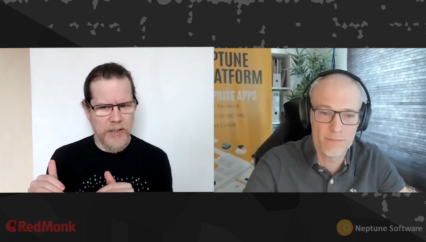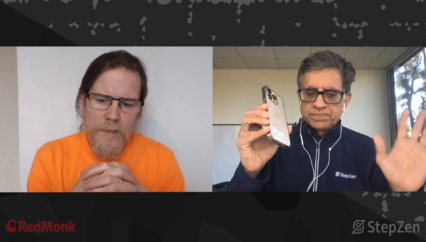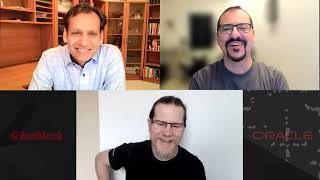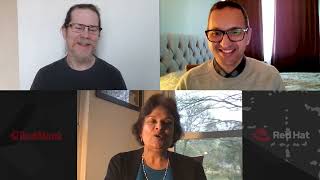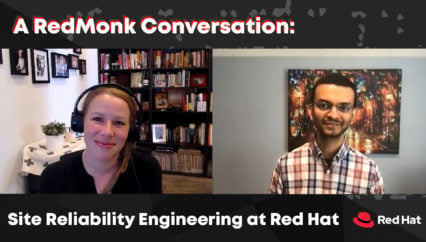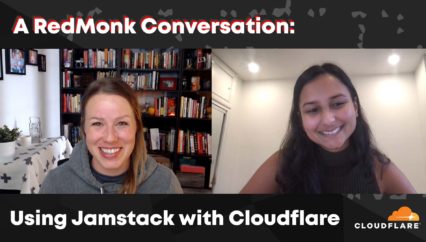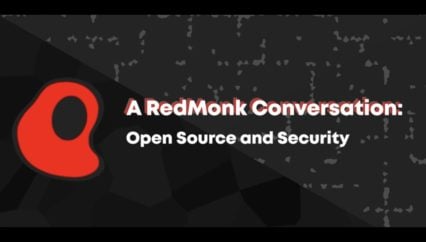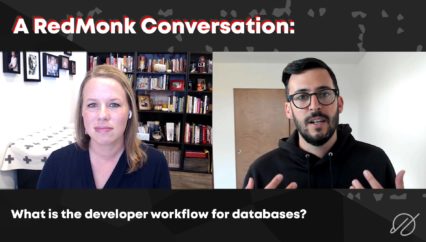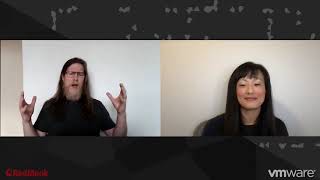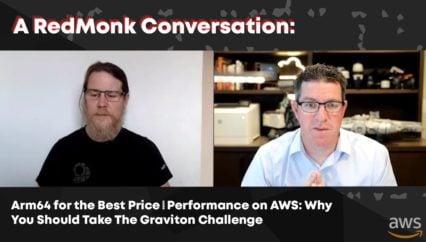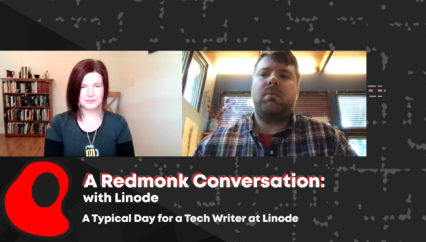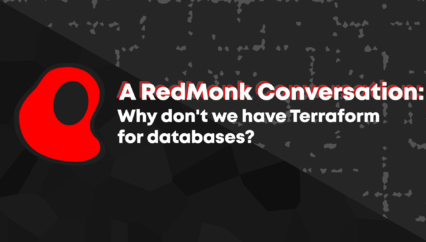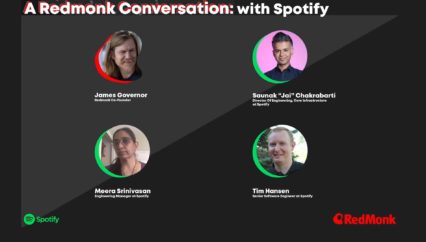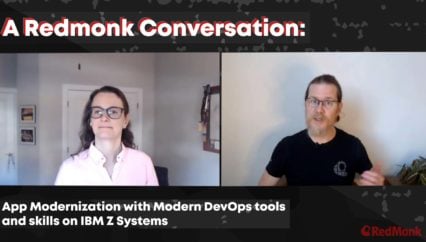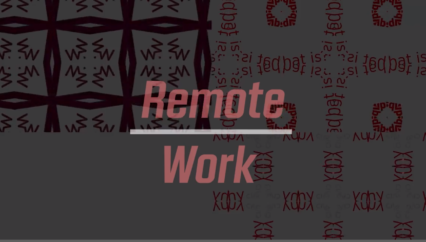In this RedMonk Conversation from IBM’s TechXchange conference, Matt Rodkey, Program Director, Product Management at IBM, speaks about and demos Bob, IBM’s newly announced agentic IDE, with RedMonk senior analyst Kate Holterhoff. Currently in private preview, Bob is designed to help enterprise developers navigate complex codebases and modernization challenges. Rodkey emphasizes that Bob’s differentiation lies in addressing enterprise deployment needs—security compliance, regulatory requirements like HIPAA and FedRAMP, and production readiness—rather than just code generation.
This RedMonk video is sponsored by IBM.
Links
Transcript
Kate Holterhoff: Hi, this is Kate Holterhoff. I’m a senior analyst at RedMonk and I’m super excited to be here at TechXchange, IBM’s developer focused conference here in Orlando, Florida. And with me, I am going to be speaking with Matt Rodkey about Bob, which is this exciting new IDE. And I’m going to learn a little bit more about it. So Matt!
Matt Rodkey: Awesome. So I’m going to demo you. We just announced Bob today this morning at the keynote of this event. I’m really excited to walk you through it. I’m going to take you through some a demo of what it would be like if you were a software developer joining a project. You don’t know the codebase at all, but you got to get up to speed really quick. How can you use this? So it’s a very typical scenario in an enterprise where new hire comes in and they want to get up to speed really quick. Bob can help. So let’s start. So we have a code base that we’ve been assigned to right here. And one of the things is really easy we can do with Bob is we can say what is the purpose. If I could type — of this application and we’ll let Bob go. But one of the things you’ll see that Bob does is Bob goes on like this is he tries to understand what you’re asking first, makes a list, a to do list, like any good planner would do to and what he needs to go through, and then walks through it step by step before coming back with an answer. And I actually find that usually when I go back to it, the answer is great. But I also like going back and looking at the thinking as they broke down, the broke down the problems.
Kate Holterhoff: Wow.
Matt Rodkey: So one of the things that you’ll, you’ll see is this application, it’s a blogging platform, social blogging platform. And Bob is pretty quick to figure out that this is one. It’s one that people use on the internet all the time for lots of these coding scenarios and simulations. So, you know, you can’t fool Bob that you that this isn’t just a fork of an existing application like that.
So, , so here you can see it’s a blogging platform. It gives me an architecture. What the front end and the back end looks like, what its core purpose is, what are its key features, effectively how it’s set up. Now, we could go a little bit further. I’m not going to do it because we’ll take a little bit more time than we want for the demo here, but I could actually also ask it to go in depth about the architecture. So I want to understand a little bit more about the components. Maybe build me a mermaid diagram of what the of what it looks like. I’m going to skip that for now, but the next thing I’m going to ask it is how do I start this application? Okay, they asked me to do it. I want to run this thing locally. Well, I’ll start this application. All right. So Bob will go and read through the files the readmes, but I think this is a really good way for us to add a new developer to a team very quickly come up to speed. Again, it’s your partner here. I don’t know if you have. Do you have any questions about that so far?
Kate Holterhoff: Yeah. Well, I mean, I just want to start by saying I had a little bit of early access to this product. And so I got to kick the tires a little bit, which is a lot of fun for me. I have spent a fair bit of time researching code assistants and some of these new ideas that are coming out, that are allowing LLMs to support developers in with their own code bases. And so yeah, I had a really good experience actually onboarding to this, to Bob and, you know, importing one of my own code bases that I it’s like a hobby project that I’ve been working on for a while and, , was able to. Yeah. See, you know, some of the things that you mentioned were the check marks as it was going through the different tasks, and I do I like that instead of just sort of veiling what’s happening behind the scenes, what Bob does is it actually highlights its own thinking process, which I think is something that I personally am looking for with these agentic IDEs. So, I mean, I also just want to say that I really like the logo for Bob. I think it’s very cute. So, you know, it’s a little, it doesn’t scream IBM to me, uh, historically
Matt Rodkey: The explanation of the thinking is, again, gets to being a partner instead of a replacement. Right? There was all the fear right now of when is this coming to replace a software developer as opposed to partner with a software developer and maybe change the role of a software developer. But partner with them. So let me go ahead and I’ll get the application started and we’ll we’ll take a look at that. All right. Let’s copy paste this. Done. Remember my keyboard shortcuts. Come on. All right. We’ll get our environment all set up. Pulled down all of our stuff. This is always an interesting one when you have to pull anything off the internet, on a demo, at a conference. But luckily it won’t take too long. It has to just pull down some npm packages here. But again, you know, I’m new to this code base. I don’t know it.
And it’s actually really true. I’ve not worked in this code base at all before. I can learn how to what it does, how I can start it. And Bob will guide me along the way with what it needs to do. Awesome. Let me type in the next step here. All right. Let’s get our database going. And we’re going to have a running web application and then make start. And we will be done. All right. Awesome. All right. It’s going to try to load it for me slowly. Let’s not cancel it. All right. So the website’s going to load. We’re going to see it’s a blogging platform when it comes up. So great. I went from zero to having the website running here in a very, very short, short period of time. Again, we’ve turned this into Bobverse, its application to blogging application platform, where we write about all of our new features here. If you were present for the keynote this morning, you’ll notice Neil did a little bit of a demo where he played with this a little bit as well. So let’s go back to the app, and I’m going to talk a little bit about how Bob can help us out with vulnerabilities and and finding things in our code. So I’m going to open up one of the Python files that makes up our application. And you notice if you can read the comments in this application, you can see actually that it does have a vulnerability in it because someone’s injected one here.
But if someone wasn’t kind enough to put those comments in here, what we can see is that Bob has actually presented us with a nice little icon here that says, I see there’s a problem right here. It says, I can add to Bob, explain with Bob and improve with Bob. I’m just going to go ahead and improve with Bob. So I’m going to say, what do we do here? So it’s going to start a new task here. Pulling in that code. It knows that block is a function that I’m working on here. And it’s going to pull it in. There’s a whole broad set of things around this called Bob findings. So Bob findings. Bob will look at things in the background. Some of it is security checks that it’s running. And there’s other things that will do that will come to the front. So think of it as a little bit more than just the general problem space in VS code, it’s findings that it has on your application. So there are some times when maybe you haven’t asked it to look for something, but it’s noticed something that it can bring to your attention that can help you fix. Right? So again, being your partner, proactively doing some things for you and not just reactive to your prompts. Right? So it’s building a security fix for us right now. So and it tells us the nice thing about it as well, when we look at vulnerabilities is Bob will not only fix it for you, but it will also help you explain it.
So again, when you need to check this change and let’s say you’ve been asked again, I’m this new guy, I’ve been asked to go fix the problem in this application that’s been not passing. It’s going to help educate me on what happened here. It’s going to give me stuff that I can put in. Bob can actually help me create my pull requests and my commit message. That has all of the right context from here in it. So again, it’s finished doing this. It gave a nice summary about what it’s done, and I can again go back and scroll through and read in all of the things that it has done, what it has changed. And how is it completed its whole task?
Kate Holterhoff: That makes sense. A use case that I’m hearing a lot for these agentic experiences is for modernizing apps. Can you talk about how Bob is helping developers to to do that particular workflow?
Matt Rodkey: Absolutely. So we initially we very much focused on that workflow with Java because we have a lot of customers in the Java space. Yes. So we have built in workflows for modernizing Java versions. Right. So that’s a big problem right? Going from Java to Java 17 Java 21. As well as Java Replatforming going from monolithic, you know, three tier GUI applications to Liberty based microservices applications. And then the third really cool thing that Bob can do there is can help you with the UI modernization. So let’s say you’re using something old like JSF or struts, right? And you want to go to something more modern like React using something like Corkus, maybe. So Bob can help you with these challenging things. They take people lots and lots and lots of time to get right. One of our Java developers told us that for one of these UI modernizations, there’s a project that typically customer might say would take them in the order of months to complete. And Bob can do it. It’s an hour, right? It’s a long task for Bob. So it’s not like, hey, it’s not instant, right? It’s not the AI is not magic. But again, if you can take months to an hour, that’s a pretty impressive gain, right?
Kate Holterhoff: Oh yeah.
Matt Rodkey: So yeah, I think we see that as a very big we see modernization as a very big thing. I think in general, AI and large language models are really good at translation type tasks, right, where they’re translating text or translating languages. So helping you modernize. I heard a really interesting one from a customer today, a customer conversation today, they were talking about a COBOL application that they maintained for shipping products around the world, and they said their customer came to them and said, with tariffs, now I need to add tariff logic to this many thousands of lines of COBOL that computes cost, right. And that’s an expensive thing to do with human developers right now, given that there’s not very many of them. Something that Bob would really excel at, right, is I could go through and add that logic to all the places that you need to apply tariffs, because if I understand your app and add it in. So I think I think modernization as well as there’s sort of the pair to modernization, which is I don’t want to modernize, but I don’t have skills to maintain. I need to maintain. And it’s hard to find skills to maintain. But I don’t want to modernize. And COBOL is the example of that. COBOL runs great on the mainframe. It’s the most optimized thing to run for certain things. And we’ve heard from customers, I don’t really want to move it. I just can’t hire enough COBOL developers. So a partner that can help you with that too. So it’s an interesting sort of pair to that modernization story. So I want to modernize stuff or I want to code something that I don’t have. I can’t hire skills for.
Kate Holterhoff: Yeah. Yeah, yeah. Okay. So this is such an exciting market to be playing in. I’m interested in how Bob is going to be differentiating itself from a lot of the other folks who are also in the IDE space.
Matt Rodkey: Yeah. And I think I think it’s a market that, there’s commercial players out there, there’s open source out there and there’s open source and open weight models out there. There’s commercial models out there. So there’s lots of different things. It is very exciting. I will say that my competitive research and I’m sure yours too. I actually have to run an agent on AI to update it like almost weekly to understand the movers and the shakers. It’s unlike any market that I’ve been in in a while.
Kate Holterhoff: Yeah. It’s wild.
Matt Rodkey: So I think what we come in and again look at the use case we’re demoing here. Some of the other ones around Java modernization. We have some ones we’re demoing around helping people do the outer loop. Things like deploying, doing security scans, configuring, using things like Terraform and Ansible. We’re approaching the problem space from what an enterprise customers need. What do large customers need. So it’s not just I need to write a new app. I’ve got this great idea. Right? I want to work on it. Right. Like a hobby project. Can you talk about your hobby project? Like. But we have to deploy it and. Okay, we’re regulated in some way, right? We’ve got HIPAA regulations or we have to deploy it for the federal government in a FedRAMP environment.
And Bob will help with those things. Like Bob is really good. We actually had an internal team that was doing FedRAMP building for FedRAMP. Using Bob saved them huge amounts of time to meet all those compliance standards with their code to go and do that stuff. And I think that is a part of the market that isn’t talked about quite as much. It’s really neat that it can help you build and explain and do these applications. All these, all these tools can. But I really think where the money is made by people who write these applications is they got to deploy them and have their customers use them, and they can’t crash and they can’t leak their information and all that. So that’s where Bob is going to, I think, try to carve its own niche in the in the market here around… we call it enterprise. But honestly, it’s really about people that are looking to deploy in production. You don’t have to be a large enterprise. You could be five people in a company. But when you want to deploy in production, managing credit card data, doing all that sort of stuff you’ve got, there are real things you have to be concerned about. And I think that’s where Bob excels.
Kate Holterhoff: Yeah, that makes sense. And another point where a lot of these agentic experiences are differentiating has to do with the models. So I’m interested in what models Bob leverages.
Matt Rodkey: Yep. So one of the things we don’t really like to talk about the models because we change them all the time. One of the things that’s really unique about what Bob does is it uses its multiple models that are in play at all times, and it tries to find for any given task that it’s going to work on. It may use more than one model, but it tries to find the best performant model along with the best cost. So also optimizing for cost. Because if you have, let’s say, a premium tier model, like a frontier class model, as well as some smaller models, and you need to do something like explain a Python function. Yeah, the cost of that, depending on which model you go to, could be 100x if you go to the frontier model, whereas the small model is just as good at that particular task. So we believe in sort of in that notion of models are becoming a commodity.
A bit here. So I think how you use the models is really smart is really important. But which models at any given time you use isn’t as important necessarily. Now, I know that every time a new model comes out, right, we’re testing it. Granite 4 just came out. There’s testing going on. How does it work when GPT 5 came out, are we testing with what GPT 5 and when Gemini comes out? Are we testing with that? So we’ve built a system where we can test with those things. But at the moment Bob doesn’t expose to you to pick which models you use. Bob has the logic to pick the right ones for you. Now in time, could we shift that? But no, we really try to move away from it’s this model that we’re hanging on to we’re picking the best model both from a price and a performance perspective for the task that you’re trying to do.
Kate Holterhoff: Fantastic. Okay. And I know we got to wrap up here soon, but I want to end on just, you know, what the roadmap is looking like for Bob. Like what are you thinking about in the future?
Matt Rodkey: Yeah. So I think a couple of things we’re going to do. One, we got to go off and we just announced today we’d love to get this thing out to the market and commercialize so that people can actually buy it and use it, not just special lucky people like you who get to use it early.
Kate Holterhoff: That’s me!
Matt Rodkey: Right? So that’s the first big number one thing on the roadmap. Yeah, I think we want to constantly be learning from one the early folks like yourself. And we’re going to expand that program in our private preview. What do we need? A couple things we know we’re going to need based on our IBM customer base is people are asking us for is there a way to do this Air Gap on premise, which we have with our current code assistant solutions. We have air gapped on premise, and we’ve seen that certainly within IBM’s customer base that are people that are asking for it. But I think we’re taking our time to look at that and understand what does that really mean? Can we offer the same value when not all the models are necessarily available to be to had in that kind of a context. So I’d say the roadmap is there. I think we’re going to continue to expand upon key domains that IBM has expertise in. We talk a lot about Java, right? On the keynote stage today, one of the founders of Hashi was up there today.
Terraform is a really big one. I’ve been working with the ansible team at Red hat quite a lot. So if we start to look at those domains on our power team, on the on IBM I, we have RPG, another fairly old language with a huge code base. They have a bunch of demos about how RPG can come out of Bob and Bob can help them both either modernize it or explain it. So I think we’re going to focus on key IBM domains and the IBM stack, whether it’s our hardware platforms, right, with power and Z, whether it’s our automation platforms, Terraform and Ansible application platforms like Java, and having those be good entry points for our customers to approach us. So come to us for a code assistant that works on those platforms that you bought from us, and then stay for a code assistant that can do all of your coding needs. So I think that’s that’s just that’s another place where Bob is a little bit, you know, kind of differentiated is we’re working for our customers first, of course, but we want to create new customers. But the customers of ours that are here for demos, for our platforms, we can, you know, we can bring them in.
Kate Holterhoff: All right. Fantastic.
Matt Rodkey: I think that’s all I have. And it’s fantastic having a conversation about this stuff. I can’t wait to work more with you as you play with it more. I know you were talking with some of Bob’s creators behind the scenes on some tips for getting your your problems solved so that you can do it. So it would be good to hear more about it. And I’m sure you’ll be writing about us, you know, in the future when you have more time.
Kate Holterhoff: All right, Matt. It’s been a pleasure.
Matt Rodkey: All right.
Kate Holterhoff: Thank you. Yeah.
Matt Rodkey: Thank you.
